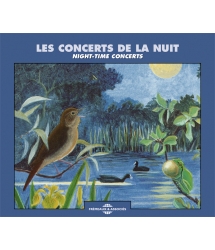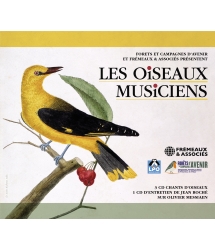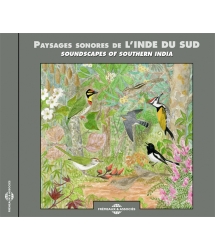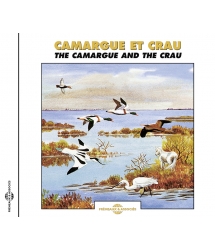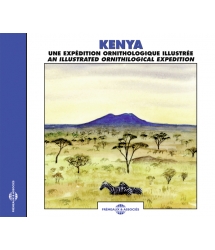- Our Catalog
- Philosophy
- Philosophers of the 20th century and today
- History of Philosophy (PUF)
- Counter-History and Brief Encyclopedia by Michel Onfray
- The philosophical work explained by Luc Ferry
- Ancient thought
- Thinkers of yesterday as seen by the philosophers of today
- Historical philosophical texts interpreted by great actors
- History
- Books (in French)
- Social science
- Historical words
- Audiobooks & Literature
- Our Catalog
- Jazz
- Blues
- Rock - Country - Cajun
- French song
- World music
- Africa
- France
- Québec / Canada
- Hawaï
- West Indies
- Caribbean
- Cuba & Afro-cubain
- Mexico
- South America
- Tango
- Brazil
- Tzigane / Gypsy
- Fado / Portugal
- Flamenco / Spain
- Yiddish / Israel
- China
- Tibet / Nepal
- Asia
- Indian Ocean / Madagascar
- Japan
- Indonesia
- Oceania
- India
- Bangladesh
- USSR / Communist songs
- World music / Miscellaneous
- Classical music
- Composers - Movie Soundtracks
- Sounds of nature
- Our Catalog
- Youth
- Philosophy
- News
- How to order ?
- Receive the catalog
- Manifesto
- Dictionnary











- Our Catalog
- Philosophy
- Philosophers of the 20th century and today
- History of Philosophy (PUF)
- Counter-History and Brief Encyclopedia by Michel Onfray
- The philosophical work explained by Luc Ferry
- Ancient thought
- Thinkers of yesterday as seen by the philosophers of today
- Historical philosophical texts interpreted by great actors
- History
- Books (in French)
- Social science
- Historical words
- Audiobooks & Literature
- Our Catalog
- Jazz
- Blues
- Rock - Country - Cajun
- French song
- World music
- Africa
- France
- Québec / Canada
- Hawaï
- West Indies
- Caribbean
- Cuba & Afro-cubain
- Mexico
- South America
- Tango
- Brazil
- Tzigane / Gypsy
- Fado / Portugal
- Flamenco / Spain
- Yiddish / Israel
- China
- Tibet / Nepal
- Asia
- Indian Ocean / Madagascar
- Japan
- Indonesia
- Oceania
- India
- Bangladesh
- USSR / Communist songs
- World music / Miscellaneous
- Classical music
- Composers - Movie Soundtracks
- Sounds of nature
- Our Catalog
- Youth
- Philosophy
- News
- How to order ?
- Receive the catalog
- Manifesto
- Dictionnary
BIRD LANDSCAPES - A SOUND AND COLOUR ILLUSTRATION
JEAN CLAUDE ROCHE
Ref.: FA688
Artistic Direction : JEAN ROCHE
Label : Frémeaux & Associés
Total duration of the pack : 1 hours 11 minutes
Nbre. CD : 1
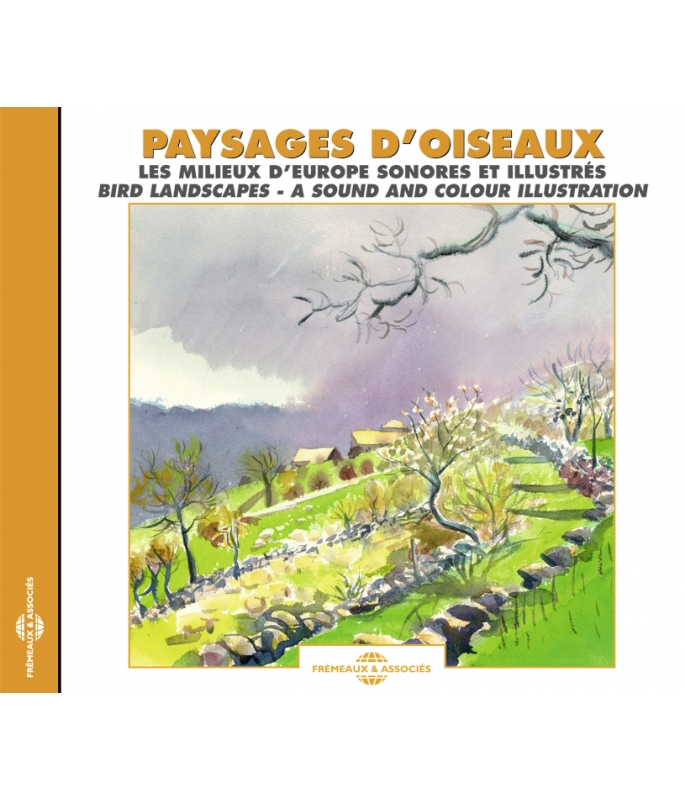
BIRD LANDSCAPES - A SOUND AND COLOUR ILLUSTRATION
BIRD LANDSCAPES - A SOUND AND COLOUR ILLUSTRATION
On this CD with an accompanying 24 page colour booklet, Jean-Claude Roché and the artist Alexis Nouailhat propose a selection of the most beautiful natural concerts by habitat: wooded, rocky, northern, Mediterranean, desert, aquatic and oceanic, of Europe and North Africa. The bio-sound recorder and the artist brought their talents together to offer a real natural hymn, both visually and acoustically.
Patrick FRÉMEAUX

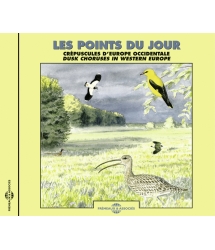
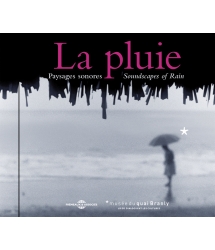
-
PisteTitleMain artistAutorDurationRegistered in
-
1Bocage et paysages humanisésSuburban hedgerows00:10:332011
-
2Forêt tempéréeTemperate forest00:02:582011
-
3Forêt primairePrimary forest00:06:152011
-
4Forêt de basse altitudeLowland forest00:05:132011
-
5Forêt de moyenne montagneMontain forest00:02:322011
-
6Pelouse alpineAlpine meadows00:01:392011
-
7FalaiseCliffs00:01:272011
-
8Toundra LaponeThe lapland tundra00:03:022011
-
9Suite ToundraTundra-continued00:03:362011
-
10TaïgaTaïga00:03:022011
-
11Suite taïgaTaïga-continued00:06:142011
-
12MaquisMaquis00:06:492011
-
13Suite maquisMaquis-continued00:02:102011
-
14DésertDesert00:05:272011
-
15Oasis de nuitAn oasis at night00:02:492011
-
16MaraisMarshes00:02:562011
-
17MerThe sea00:01:382011
-
18Suite MerThe sea-continued00:02:432011
Paysages dfOiseaux
Paysages d’Oiseaux
les milieux d’europe sonores et illustrés
Bird landscapes - a sound and colour illustration
Les milieux d’Europe illustrés – Jean-Claude Roché
(Banne, le 9 février 2009)
Après avoir fait ensemble le double CD “Drôles d’Oiseaux”, dédié aux oiseaux qui ont des chants musicaux ou curieux, le peintre Alexis NOUAILHAT et moi avons eu envie de faire un second CD, mais cette fois-ci sur les milieux. Bien entendu, la correspondance entre une aquarelle et une prise de son ne peut pas être précise, puisque l’aquarelle couvre souvent un paysage élargi, alors que la prise de son est, par définition, ponctuelle. Nous avons sélectionné les plus belles aquarelles des différents des milieux arborés, rocheux, nordiques, méditerranéens, désertiques, aquatiques et marins (d’Europe de l’Ouest et du Maghreb), et mes plus beaux concerts naturels enregistrés dans ces mêmes milieux. Ce CD n’est donc pas un ouvrage scientifique, c’est un simple hommage à la beauté de la Nature, qu’il s’agisse de ses paysages visuels, ou de ses paysages sonores, avec oiseaux, mammifères, amphibiens et insectes.
Jean-Claude Roché
© Frémeaux & Associés
MILIEUX ARBORÉS
1 Bocage et paysages humanisés (Sud Angleterre)
Moment calme de la journée, les solistes se relaient, l’un après l’autre.
Merle noir (chant d’un mâle posé)
Grive musicienne (chant d’un mâle posé)
Fauvette des jardins (chant d’un mâle posé)
Alouette des champs (chant d’un mâle en vol)
Moutons
2 Forêt tempérée (Forêt de Tronçais, enregistrement Olivier Dumas)
Concert nocturne du début de la nuit, fin septembre.
Cerfs rouges ou élaphes (brames de mâles en période de rut)
Grillons d’Italie (chant nocturne)
3 Forêt primaire (Bialowiéja, Pologne)
Concert de l’aube, où se mêlent les chants des oiseaux nocturnes et diurnes, avec cet “écho de cathédrale” spécial de la grande forêt primaire.
Grive musicienne (chant d’un mâle posé)
Merle noir (chant d’un mâle posé)
Chouette hulotte (chant d’un mâle posé)
Rossignol progné (chant d’un mâle posé)
Coucou gris (chant d’un mâle posé)
Pouillot siffleur (chant d’un mâle posé)
4 Forêt de basse altitude (bas Jura)
Concert de la matinée, sur la fin, au milieu d’une grande héronnière.
Fauvette des jardins (chant d’un mâle posé)
Pic mar (cris et chants d’un mâle en parade sur les troncs)
Mésange charbonnière (chant d’un mâle posé)
Pic épeiche (tambourinages et chants d’un mâle)
Loriot (chant d’un mâle posé)
Corneille noire (cris habituels)
Hérons cendrés (cris dans la héronnière, sur les nids)
Merle noir (chant d’un mâle posé)
Grive draine (chant d’un mâle posé)
5 Forêt de moyenne montagne (Trièves)
Ambiance du crépuscule, ou se mêlent les vous des oiseaux diurnes et nocturnes.
Pic noir (tambourinage, cris de parade, et chant, successivement)
Bouvreuil pivoine (chant d’un mâle posé)
Buses variables (cris d’un couple en vol nuptial)
Beccroisés des sapins (cris d’une bande)
Coucou gris (chant d’un mâle posé)
Grive draine (chant d’un mâle posé)
Pouillot véloce (chant d’un mâle posé)
Chouette de Tengmalm (chant d’un mâle posé, à la tombée de la nuit)
MILIEUX ROCHEUX
6 Pelouse alpine (Col du Galibier)
Ambiance du matin ponctuée par les ris des Marmottes.
Marmottes (cris d’alarme habituels)
Alouette des champs (chant d’un mâle en vol)
Traquet motteux (chant d’un mâle en vol)
Lagopède alpin (chant d’un mâle posé et en vol)
Niverolle (chant d’un mâle en vol)
7 Falaise (Alpes de Haute Provence)
Les voix de quelques unes des espèces bien spéciales des falaises.
Grand Corbeau (cris habituels)
Martinets alpins (chants et cris d’une troupe en vol)
Une grosse pierre se détache de la falaise
Chocard à bec jaune (cris aigus habituels)
Faucon pèlerin (chant d’un mâle, puis cris d’alarme autour de l’aire)
MILIEUX NORDIQUES
8 Toundra lapone (Karigasniemi, Finlande)
Au matin, dans la toundra, retentissent des cris aux sonorités de trompettes.
Cygnes chanteurs (cris d’un couple près de son nid)
Grues cendrées (chants d’un couple près de son nid)
Courlis corlieu (cis habituels en vol ou au posé)
Oies cendrées (cris d’un couple en vol)
Chevalier aboyeur (chant d’un mâle en vol)
9 Suite toundra (même lieu)
Les chants des Grives mauvis dominent le concert matinal.
Grive mauvis (chant d’un mâle posé)
Pic tridactyle (tambourinages d’un mâle)
Pluvier doré (cris fins et aigus, puis chant de parade en vol sur 2 notes)
Tétras lyre (chant et chuintements d’un mâle en parade)
10 Taïga (environs de Rovaniemi, au cercle Polaire, Finlande)
Les trilles douces et descendantes du Pouillot fitis sont omniprésentes.
Grive litorne (cris et chants d’un mâle posé)
Pouillot fitis (chant d’un mâle posé)
Bruant rustique (chant d’un mâle posé)
11 Suite taïga (même lieu)
Les voix du matin sont nombreuses dans clairières avec marécages.
Pinson du Nord (chant d’un mâle posé
Bécassine des marais (chant rythmé d’un mâle posé et en vol)
Petit Tétras (chant d’un mâle en parade au sol)
Courlis corlieu (cris habituels)
Grive mauvis (chant d’un mâle posé)
Chevalier arlequin (chant d’un mâle en vol)
Traquet tarier (chant d’un mâle posé)
MILIEUX MÉDITERRANÉENS
12 Maquis (Delphes, Grèce)
Le concert de l’aube comporte de grands virtuoses.
Sittelle des rochers (chant d’un mâle dans les rochers)
Troupeau de chèvres
Traquet oreillard (chant d’un mâle posé sur un rocher)
Merle bleu (chant d’un mâle posé sur un éperon rocheux)
Fauvette orphée (chant d’un mâle posé dans le feuillage)
Bruant cendrillars (chant d’un mâle posé sur un buisson)
13 Suite maquis (même lieu)
Ambiance du soir, avec un bel écho dans les rochers.
Clochettes de chèvres
Chouette chevêche (chant nocturne d’un mâle caché dans un trou de rochers)
Martinets alpins (chants d’une troupe en vol)
Merle bleu (chant d’un mâle à la tombée de la nuit)
MILIEUX DÉSERTIQUES
14 Désert (près de Ouarzazate, Sud Maroc)
Les phrases sifflées du Sirli contrastent avec les cris des Gangas qui traversent le ciel.
Gangas catas (chant d’une troupe en vol)
Sirli du désert (chant d’un mâle posé sur un caillou)
Gangas couronnés (cris de petits groupes en vol)
Gangas unibandes (cis de petits groupes en vol)
15 Oasis de nuit (Sud Maroc, près de Taroudant)
Des voix bien étranges pour nos oreilles européennes !
Crapauds africains (chant des mâles à la tombée de la nuit, au bord de l’eau)
Chouettes hulottes africaines (chants d’un couple paradant de nuit)
Engoulevent à collier roux (chant d’un mâle posé, de nuit)
MILIEUX AQUATIQUES
16 Marais (en Brenne)
Concert diffus avec tant de voix mêlées, typique des zones humides.
Phragmite des joncs (chant d’un mâle posé sur un roseau)
Merle noir (chant d’un mâle posé)
Ambiance sonore globale de la roselière
Coucou gris (chant d’un mâle posé)
Faisan de Colchide (chant d’un mâle posé à terre)
MILIEUX MARINS
17 Mer (Ile Rouzic, en Bretagne)
Voix puissantes des oiseaux marins, qui dominent le bruit de la mer !
Guillemots de Troïl (cris habituels dans la colonie)
Goélands argentés (ambiance habituels, ils sont nombreux)
Macareux moine (grognements au seul du terrier)
Cormorans (cris d’une femelle défendant son nid)
18 Mer (Ile Riou, au large de Marseille)
Légende de marins : les cris des Puffins seraient ceux des âmes d’enfants morts.
Puffins cendrés (cris de parades en vol, de nuit, autour des terriers, début mai)
Pétrel tempête (chant d’un mâle, de nuit, au fond d’une crevasse rocheuse)
Jean-Claude Roché
Banne, le 9 février 2009
Illustrations : Aquarelles d’Alexis Nouailhat
© Frémeaux & Associés
Bird landscapes – Jean-Claude Roché
Banne, 9th February 2009
After having produced the double CD “Drôles d’Oiseaux” together, a CD of birds with very musical or curious songs, the painter Alexis Nouailhat and I wanted to make a second CD, but this time concerning habitats. Obviously, the correlation between an artist and sound recorder can’t be precise as the picture often covers the whole habitat whereas the sound recording, by definition, is much more selective. The best water-colours of the different habitats have been selected: wooded, rocky, northern, Mediterranean, desert, wetland and oceanic (of Western Europe and North Africa), and the most beautiful natural concerts that were recorded in these same habitats. This CD isn’t then a scientific work but simply homage to the beauty of the natural world, whether it’s either their visual or sound landscapes with their different birds, mammals, amphibians and insects.
Jean-Claude Roché
Translated in English by Tony Williams
© Frémeaux & Associés
Wooded habitats
1 Suburban hedgerows (southern England)
During a quiet moment of the day, soloists follow each other.
Blackbird (song of a male perched)
Song Thrush (song of a male perched)
Garden Warbler (song of a male perched)
Skylark (a male singing in flight)
Sheep
2 Temperate forest (Forêt de Tronçais, central France, recording: Olivier Dumas)
A nocturnal concert at dusk, late September
Red Deer (rutting males)
3 Primary forest (Bialowiéja, Poland)
Dawn chorus, when the voices of nocturnal and diurnal birds mingle, with that cathedral-like echo that’s special to the great primary forests.
Song Thrush (song of a male perched)
Blackbird (song of a male perched)
Tawny Owl (song of a male perched)
Thrush Nightingale (song of a male perched)
Cuckoo (song of a male perched)
Wood Warbler (song of a male perched)
4 Lowland forest (lower Jura, eastern France)
Morning concert, reaching its end, in the middle of a large heronry
Garden Warbler (song of a male perched)
Middle Spotted Woodpecker (calls and song of a displaying male on a tree trunk)
Great Tit (song of a male perched)
Great Spotted Woodpecker (drumming and songs of a male)
Golden Oriole (song of a male perched)
Carrion Crow (typical calls)
Grey heron (calls at the heronry, from the nest)
Blackbird (song of a male perched)
Mistle Thrush (song of a male perched)
5 Mountain forest (Trièves – French Alps)
An atmosphere of dusk, with its mix of the sounds of both diurnal and nocturnal birds.
Black Woodpecker (successive drumming, display call and song)
Bullfinch (song of a male perched)
Common Buzzards (calls of a displaying pair)
Common Crossbill (calls of a flock)
Cuckoo (song of a male perched)
Mistle Thrush (song of a male perched)
Chiffchaff (song of a male perched)
Tengmalm’s Owl (song of a male perched, at dusk)
Rocky habitats
6 Alpine meadows (Col de Galibier – French Alps)
A morning atmosphere, punctuated by Marmot calls.
Marmots (normal alarm calls)
Skylark (song of a male in flight)
Northern Wheatear (song of a male in flight)
Willow Grouse (song of a male perched and in flight)
Snowfinch (song of a male in flight)
7 Cliffs (The Alpes de Haute Provence, southern France)
The calls of a few species typical of cliffs
Raven (normal calls)
Alpine Swift (song and calls of a flock in flight)
A large rock falls from the cliff
Alpine Chough (normal high-pitched calls)
Peregrine (a male calling, then alarm calls around the eyrie)
Habitats of the far North
8 The Lapland tundra (Karigasniemi, Finland)
In the morning, on the tundra, resounding with trumpet-like calls.
Whooper Swan (calls of a pair near their nest)
Common Crane (display calls of a pair near their nest)
Whimbrel (typical calls in flight and whilst perched)
Greylag Goose (calls of a pair in flight)
Greenshank (a male singing in flight)
9 Tundra – continued (same place)
Redwing song dominates the dawn chorus.
Redwing (song of a male perched)
Three-toed Woodpecker (a male’s drumming)
Golden Plover (sharp, clear calls, then two note display-flight song)
Black Grouse (song and hissing of a male displaying)
10 The Taiga (near Rovaniemi, within the Arctic circle, Finland)
The soft, descending trill of the Willow Warbler is everywhere.
Fieldfare (Calls and song of a male perched)
Willow Warbler (song of a male perched)
Rustic Bunting (song of a male perched)
11 The Taiga – continued (same place)
In the morning there are numerous sounds in the marshy clearings.
Brambling (song of a male perched)
Snipe (the rhythmic “song” of a male on the ground and in flight)
Redwing (Calls of a displaying male on the ground)
Whimbrel (typical calls)
Redwing (song of a male perched)
Spotted Redshank (song of a male in flight)
Stonechat (song of a male perched)
Mediterranean habitats
12 Maquis (Delphes, Greece)
The dawn chorus with some fine virtuosos
Rock Nuthatch (song of a male hidden in the rocks)
Herd or goats
Black-eared Wheatear (song of a male perched on a rock)
Blue Rock Thrush (song of a male perched on a rocky outcrop)
Orphean Warbler (song of a male hidden in foliage)
Cinereous Bunting (song of a male perched on a bush)
13 Maquis – continued (same place)
Evening atmosphere, with clear echoes from the rocks
Goat bells
Little Owl (nocturnal song from a male hidden in a rock hole)
Alpine Swifts (calls from a flock in flight)
Blue Rock Thrush (a male’s song at dusk)
Desert habitats
14 Desert (near Ouarzazate, southern Morocco)
The whistled phrases of the Hoopoe Lark contrast with the calls of Sandgrouse passing in flight.
Pin-tailed Sandgrouse (calls from a flock in flight)
Hoopoe Lark (song of a male perched on a stone)
Crowned Sandgrouse (calls from a small flock in flight)
Black-bellied Sandgrouse (calls from a small flock in flight)
15 An oasis at night (near Taroudant, southern Morocco)
Strange sounds for European ear!
African toads (males calling at dusk, on the water’s edge)
African Tawny Owls (calls of a pair displaying at night)
Red-necked Nightjar (Song of a perched male, at night)
Wetland Habitats
16 Marshes (in the Brenne, central France)
A diffused concert with a mixture of many sounds so typical of wetlands.
Sedge Warbler (Song of a male perched on a reed)
Blackbird (song of a male perched)
The sound atmosphere within a reedbed
Cuckoo (song of a male perched)
Pheasant (display calls of a male on the ground)
Oceanic Habitats
17 The Sea (Ile Rouzic, Brittany, north-west France)
Common Guillemots (typical calls at a colony)
Herring Gulls (typical atmosphere, they’re numerous)
Puffin (groaning at the burrow entrance)
Cormorants (calls of a female defending her nest)
18 The Sea (Ile Riou, off the coast of Marseille, Mediterranean)
A mariners legend: shearwaters calls are those of the souls of lost children.
Cory’s Shearwater (display calls in flight around the burrows, at night, in May)
Storm Petrel (a male’s song, at night, from the bottom of a rock crevice)
Jean-Claude Roché
Banne, 9th February 2009
Translated in English by Tony Williams
Illustrations : Aquarelles by Alexis Nouailhat
© Frémeaux & Associés
CD Paysages d’Oiseaux © Frémeaux & Associés / Droits audio : Frémeaux & Associés - La Librairie Sonore (Producteur initial : Sittelle, Pithys, Collection Allain Bougrain Dubourg ou Ceba) / Ecouter les chants d'oiseaux sur CD : Sons et ambiances naturelles des écosystèmes - Stéreo and digital recording of the natural landscape sound. Natural sound sceneries of écosystems, Voices of the Wild Life. Les droits de cet enregistrement sont protégés par la loi. Pour toute exploitation d’illustration sonore sur CD, DVD, CD-Rom, Télévision, Cinéma, Sites internet, scénographies (théâtre, musées…), l’autorisation et un devis gratuit peuvent être obtenus auprès de Frémeaux & Associés – fax : +33 (0)1 43.65.24.22 info@fremeaux.com
